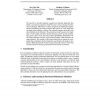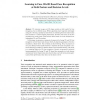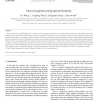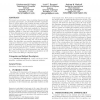167 search results - page 4 / 34 » LIFT: A new framework of learning from testing data for face... |
ICARCV
2008
IEEE
14 years 1 months ago
2008
IEEE
—Face recognition performance depends upon the input variability as encountered during biometric data capture including occlusion and disguise. The challenge met in this paper is...
NIPS
2000
13 years 8 months ago
2000
We describe a neurally-inspired, unsupervised learning algorithm that builds a non-linear generative model for pairs of face images from the same individual. Individuals are then ...
AMFG
2005
IEEE
14 years 1 months ago
2005
IEEE
2D intensity images and 3D shape models are both useful for face recognition, but in different ways. While algorithms have long been developed using 2D or 3D data, recently has see...
PR
2007
13 years 7 months ago
2007
Face recognition is a challenging task in computer vision and pattern recognition. It is well-known that obtaining a low-dimensional feature representation with enhanced discrimin...
GECCO
2009
Springer
14 years 2 days ago
2009
Springer
We present a novel stereo vision modeling framework that generates approximate, yet physically-plausible representations of objects rather than creating accurate models that are c...




